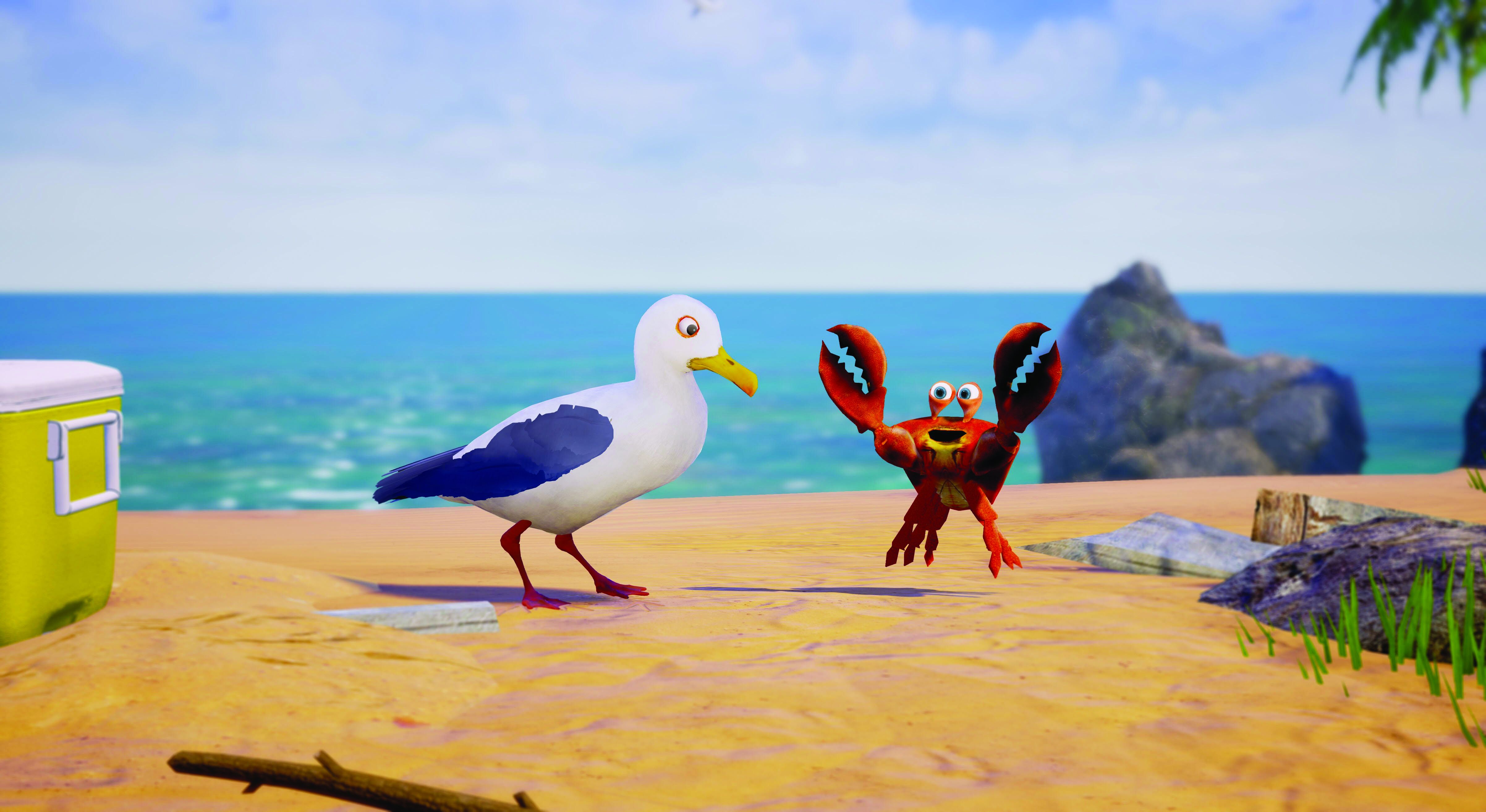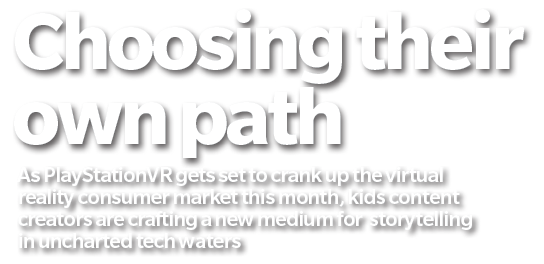For kids content writers looking for new challenges in cross-platform story production, the days of the classic, three-act narrative structure may be over. The arrival of 360-degree, interactive storytelling through virtual and augmented reality is shaking the very notion of how people respond to characters and stories to its core.
Brands like HTC Vive, HoloLens and Magic Leap don’t sound unfamiliar anymore. And despite the fact that mainstream adoption of VR hasn’t happened yet, there’s no denying its massive potential for multiple industries including entertainment, education, medicine and sports, to name just a few.
In fact, according to global market intelligence firm International Data Corporation (IDC), worldwide revenues for the VR/AR market will skyrocket from US$5.2 billion this year to more than US$162 billion by 2020, representing an annual growth rate of 181%.
How the VR market actually pans out will, of course, hinge on lower retail price-points for hardware and the development of innovative new software and applications. One emerging independent company currently at the forefront of VR technology is L.A.-based interactive character studio Motional.
Founded by Pixar alum Mark Walsh, whose credits over his 18-year career include being an animation supervisor for Finding Nemo and Ratatouille, Motional is focused on creating active, emotional experiences between people and interactive characters in VR worlds.
Walsh says one of the main reasons for starting the company was seeing how passive many of today’s virtual reality experiences have become.
“With virtual reality right now, if you see a character walk by and you wave to them, they ignore you. It makes you feel like a high school outcast, which is bad because VR is hopefully meant to make you feel good,” he says. “I wanted to prove a theory that people would want to meet an interesting character in an amazing world.”
The fruits of Walsh’s idea soon materialized with Gary the Gull (pictured), a short conversational, self-funded animated VR film starring a wisecracking yet charming seagull out to steal lunches from unsuspecting beach-goers.
Using technology from Seattle-based virtual reality startup Limitless, a company run by another former Pixar man Tom Sanocki (Finding Nemo, Up), Gary the Gull lets viewers interact with its feathered protagonist through voice recognition, gestures and gaze.
During a successful test at this year’s Game Developers Conference in San Francisco, Walsh says most people who came to check out the demo just wanted to laugh and try out the alternate ways of experiencing the film by answering differently to Gary.
“Interestingly, there were a lot of younger men asking why they couldn’t run and jump, or shoot or strangle Gary because they’re used to playing first-person adrenaline-pumping video games,” he says. “However, women really responded to being able to create a relationship with the character, which is a different use of a video game system and a different use of VR.”
Sony also responded well to the film and will be including it as part of its PSVR launch in October, a move that caught Walsh off guard. “Now that it’s a success story, and depending on how audiences react to their experience on the PS4, we are deciding whether or not to expand Gary to a longer format,” he says.
Walsh hopes the VR experience will help teach empathy and social skills to kids who have become less sociable because of texting and device obsessions.
“You can yell at Siri and call her all sorts of nasty names and she won’t even get angry. It’s very much like yelling at video games on the screen, but in real life we all need to learn that those behaviors aren’t acceptable,” he says. “Gary gives you the feeling of a real relationship and can also train you behaviorally on what is an appropriate way to treat somebody.”
While Gary prepares to spread his wings this fall, another kid- and family-friendly interactive character will soon make its way to virtual reality, thanks to Google and UK-based Nexus Productions.
Also set for an October release, Rain or Shine is a 360-degree VR film from Nexus that’s being touted as the most interactive Google Spotlight Story ever.
Launched in 2013, Google Spotlight Stories is a new form of interactive, 360-degree storytelling made specifically for mobile and VR that features 3D and 2D animation, 360-degree spherical cinema-quality video, full-sphere surround sound and motion sensor-driven story options.
Set on a beautiful sunny day in a square in London, Rain or Shine follows an amiable young girl named Ella who discovers, much to her frustration, that whenever she puts on her sunglasses a raincloud appears above her head and promptly soaks her.
At launch, the film will be accessible via the YouTube app and Chrome or FireFox (for PCs), and it will be coupled with a new Google Cardboard headset and Android phone.
Nexus executive producer Luke Ritchie says the company did its best to make Rain or Shine feel as interactive as possible. It gives viewers the ability to make choices to follow micro sub-plots, at certain points, while popping in and out of the main story, which is out of their control.
“We don’t punish you for looking in the wrong direction, but at the same time, we don’t continue the story if you don’t follow Ella,” says Ritchie.
For example, at one point Ella is at an ice cream truck. If the viewer decides to look in any other direction, they’ll see a bird land on the pavement. Look to the left, and they’ll see a cat. Keep looking, the user views the cat chasing the bird, which eventually flies up, over and back onto the truck. “Almost 95% of viewers follow the bird,” says Ritchie. “So we’re forever working out ideas and techniques to get viewers back to the main story.”
To help sort out all the storylines, Nexus used a special script board marked by location and time.
“The idea is you sort of write the linear film in your head and it almost becomes a diagonal line from the top corner of the board to the bottom corner,” he says. “Ideally, that’s the story you want to follow.”
Considering the time and effort required to make VR short films, they are not cheap to produce.
“You can develop apps for US$50,000 now, but if you want to develop a short film in VR it’s a big number,” says Ritchie, who also freelances as a VR analyst.
He says this Christmas, however, VR companies will be pushing their devices and more people will be looking for content. “So there might be a bubble where we can actually make decent returns on short films in VR,” Ritchie posits. “I’m not going to compete with the high-end games like Portal or Valkyrie, so it seems obvious that there probably is an area where you might want to pay to feel like you’re a part of an amazing Disney short film.”
Ritchie also believes it will get easier to develop less expensive VR projects because most of them are now built in game development platform Unity. And new companies like Sketch, which offers simple ways to upload design mockups to VR, are popping up.
Unity, in fact, recently completed a series C investment round of US$181 million to drive the VR/AR sector. The middleware company currently boasts 5.5 million registered developers and 4.2 billion games made with its technology in Q1 2016, including the global phenomenon that is Pokémon GO.
“But for high-end VR stories that require a lot of investment and thought process, in some ways, it’s never going to get easier,” adds Ritchie.
Understanding how much sacrifice is required to produce a bigger VR project is something not lost on Mo Davoudian of L.A.-based Brain Zoo Studios (Pepe & Lucas).
The CGI animation company’s creative director and CEO is currently nearing the end of a 22-year mission to complete Brain Zoo’s original CGI-animated short film, Nora. (It’s being produced with co-creator/designer Farzad Varahramyan, co-creator Ali Donovan and a team of film, VR and gaming vets.)
Nora, which is also being developed as a traditional TV and VR series using real-time gaming engines, provides a family-friendly mix of comedy, sci-fi and action-adventure set in a retro future, where an odd couple must team up to save their world from the brink of destruction.
“The timing for the project right now is perfect because we’re seeing film and gaming technologies really come together with VR,” says Davoudian. “It started out as a short film as a proof of concept for a feature, but as time went on we saw that, while it still has great potential for a feature, it has even more potential as a series in VR.”
Nora is currently in the scriptwriting and early development phase for a planned 26 x half-hour series, and Davoudian says Brain Zoo expects to maintain a level of quality and visual design not normally found in TV animation.
He contends that kids are much more sophisticated today than they were five years ago. “A lot of what’s on TV still panders to the old ways of almost talking down to kids, instead of understanding that they get a lot more than we think they do,” Davoudian notes.
“We’re looking for producing partners who have a vision for something greater. We’re planning for the series to be available in such a way that if a person doesn’t have the VR hardware, they won’t miss out. The VR experience will just enhance what’s there.”
Looking at broader opportunities for kids and VR, Davoudian says one thing people are not currently paying a lot of attention to is YouTube’s 360-degree platform.
“Kids can take advantage because they can grab their parents’ iPads or iPhones and watch the videos in VR without wearing a headset, so it doesn’t affect their development,” he says. “And the distribution is worldwide. You can reach more people much faster than you would if you needed a headset.”
Like Brain Zoo, UK-based Plug-in Media, which is known for content aimed at younger kids, including CBeebies’ Tee and Mo, is also delving into Unity-driven production with its new BBC-commissioned VR animated sitcom Angie’s Party.
Built for Google Cardboard, and inspired by interactive theater like Punch Drunk’s hit stage production Sleep No More, the story features 11 minutes of content embedded within five linear minutes and plays out over the title character’s 16th birthday party.
Using long-stare motion tracking, viewers can choose their own storylines to follow apart from the main action, much like a Google Spotlight Story.
Though targeting an older 16 to 23 audience, Plug-in also has plans to launch a VR drama for tweens.
“We’ve written a proposal around bullying targeting 10- to 14-year-olds, because it’s a very interesting topic to explore in such an immersive way from so many different perspectives,” says Plug-in MD Juliet Tzabar.
While opinions vary wildly on the current state and long-term outlook of the VR industry, it’s generally agreed that mobile will help bring virtual reality to the masses in a faster, more affordable way. Notably, Google’s Daydream VR launch this fall is promising a higher-quality mobile experience than Cardboard and a controller, as Daydream-compatible phones hit the market. Hulu will also have a presence on the platform, along with game companies like Ubisoft and many YouTube stars including iJustine.
“For me, the biggest market will be mobile, but another thing that is coming is Google’s Tango Project, which is like the Microsoft Kinect, but in a phone,” says Ritchie.
Out this September on the Lenovo Phab2 Pro superphone, Tango uses indoor mapping technology and augmented reality that lets your phone become a window into virtual worlds.
“Once you put on the experience, it’s like taking a beautiful Pixar film and having all the characters in your bedroom with you,” says Ritchie.
In fact, while VR revenues are expected to be greater than AR-related ones into 2017 (driven by consumer growth of games and paid content), IDC expects AR will overtake VR by 2018.
Growing a content ecosystem
Fans of creator Kyle A. Carrozza’s hit Cartoon Network micro-series Mighty Magiswords will get to extend their quests for swords when the Cartoon Network Anything 15-second interactive toon makes its full-length series debut on September 29.
While no plans are in the works to experiment with virtual reality, Cartoon Network will launch a whopping 400 pieces of customized, platform-specific Mighty Magiswords original content in the form of shorts, vlogs, web and mobile games, and interactive narrative content in tandem with the new 11-minute linear series.
The Cartoon Network Studios comedy-adventure, its first original digital show, follows the adventures of a brother-and-sister warrior duo who wield a collection of silly and sometimes magical swords in battle.
Since launching on CN’s snackable content-focused micro-network, the Watch Cartoon Network video app and CartoonNetwork.com, Mighty Magiswords has given fans new ways to immerse themselves with its characters and stories.
Notably, every micro-short lets kids choose between swords, with each one determining a different outcome of the narrative.
For Carrozza (The SpongeBob Movie: Sponge Out of Water), one of the biggest challenges has been learning to write longer Magiswords episodes.
“I originally pitched a show for television, not a 15-second cartoon, but the way that it’s been produced has worked in the show’s favor,” Carrozza says. “There was definitely a little bit of trial and error when we made the 15-second episodes and the three-minute stories.”
As far as coordinating so much ancillary content goes, Carrozza says he has the help of a good-sized team, but not every story gets fleshed out.
“I don’t want to have an Avatar level of backstory or I’d be too precious about things. If there were times when we ran into continuity that negated itself, we generally figured out how to explain it away because I love making fun of continuity,” he says.
“That said, I try to make every piece of content in a way that if it was your first experience with the IP, you could generally understand what’s going on. But if you have been tracking everything, there are rewards for paying attention.”
With so many different formats and fan experiences for shows across platforms today, Carrozza says the one thing that should remain consistent is strong characters and personalities.
“You can’t depend on the gimmick or the technology. VR has been on people’s lips for so many decades now and has never quite become a thing, but people also said that 3D movies were a fad and they’re still here,” he says. “I am more interested in being adaptable. I can make Mighty Magiswords content for whatever format happens to roll along.”



























